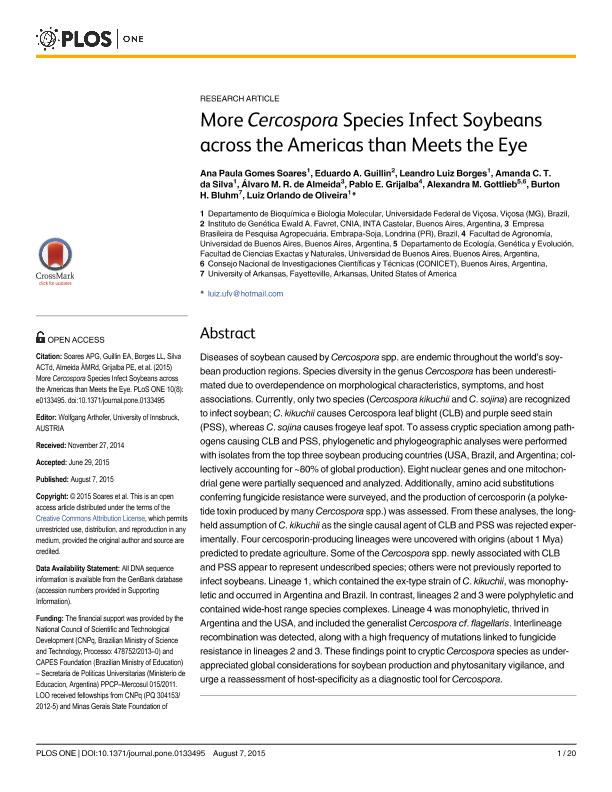Mostrar el registro sencillo del ítem
dc.contributor.author
Soares, Ana Paula Gomes
dc.contributor.author
Guillin, Eduardo A.
dc.contributor.author
Borges, Leandro Luiz
dc.contributor.author
Da Silva, Amanda C. T.
dc.contributor.author
De Almeida, Álvaro M. R.
dc.contributor.author
Grijalba, Pablo Enrique

dc.contributor.author
Gottlieb, Alexandra Marina

dc.contributor.author
Bluhm, Burton H.
dc.contributor.author
De Oliveira, Luiz Orlando
dc.date.available
2018-09-21T18:49:51Z
dc.date.issued
2015-08
dc.identifier.citation
Soares, Ana Paula Gomes; Guillin, Eduardo A.; Borges, Leandro Luiz; Da Silva, Amanda C. T.; De Almeida, Álvaro M. R.; et al.; More Cercospora species infect soybeans across the Americas than meets the eye; Public Library of Science; Plos One; 10; 8; 8-2015; 1-20
dc.identifier.issn
1932-6203
dc.identifier.uri
http://hdl.handle.net/11336/60607
dc.description.abstract
Diseases of soybean caused by Cercospora spp. are endemic throughout the world's soybean production regions. Species diversity in the genus Cercospora has been underestimated due to overdependence on morphological characteristics, symptoms, and host associations. Currently, only two species (Cercospora kikuchii and C. sojina) are recognized to infect soybean; C. kikuchii causes Cercospora leaf blight (CLB) and purple seed stain (PSS), whereas C. sojina causes frogeye leaf spot. To assess cryptic speciation among pathogens causing CLB and PSS, phylogenetic and phylogeographic analyses were performed with isolates from the top three soybean producing countries (USA, Brazil, and Argentina; collectively accounting for ∼80% of global production). Eight nuclear genes and one mitochondrial gene were partially sequenced and analyzed. Additionally, amino acid substitutions conferring fungicide resistance were surveyed, and the production of cercosporin (a polyketide toxin produced bymany Cercospora spp.) was assessed. From these analyses, the longheld assumption of C. kikuchii as the single causal agent of CLB and PSS was rejected experimentally. Four cercosporin-producing lineages were uncovered with origins (about 1 Mya) predicted to predate agriculture. Some of the Cercospora spp. newly associated with CLB and PSS appear to represent undescribed species; others were not previously reported to infect soybeans. Lineage 1, which contained the ex-type strain of C. kikuchii, was monophyletic and occurred in Argentina and Brazil. In contrast, lineages 2 and 3 were polyphyletic and contained wide-host range species complexes. Lineage 4 was monophyletic, thrived in Argentina and the USA, and included the generalist Cercospora cf. flagellaris. Interlineage recombination was detected, along with a high frequency of mutations linked to fungicide resistance in lineages 2 and 3. These findings point to cryptic Cercospora species as underappreciated global considerations for soybean production and phytosanitary vigilance, and urge a reassessment of host-specificity as a diagnostic tool for Cercospora.
dc.format
application/pdf
dc.language.iso
eng
dc.publisher
Public Library of Science

dc.rights
info:eu-repo/semantics/openAccess
dc.rights.uri
https://creativecommons.org/licenses/by-nc-sa/2.5/ar/
dc.subject
Soybean
dc.subject
Phylogenetic
dc.subject
Analysis
dc.subject
Phylogeography
dc.subject.classification
Otras Ciencias Biológicas

dc.subject.classification
Ciencias Biológicas

dc.subject.classification
CIENCIAS NATURALES Y EXACTAS

dc.title
More Cercospora species infect soybeans across the Americas than meets the eye
dc.type
info:eu-repo/semantics/article
dc.type
info:ar-repo/semantics/artículo
dc.type
info:eu-repo/semantics/publishedVersion
dc.date.updated
2018-09-19T14:33:23Z
dc.journal.volume
10
dc.journal.number
8
dc.journal.pagination
1-20
dc.journal.pais
Estados Unidos

dc.journal.ciudad
San Francisco
dc.description.fil
Fil: Soares, Ana Paula Gomes. Universidade Federal de Viçosa; Brasil
dc.description.fil
Fil: Guillin, Eduardo A.. Instituto Nacional de Tecnología Agropecuaria. Centro Regional Buenos Aires; Argentina
dc.description.fil
Fil: Borges, Leandro Luiz. Universidade Federal de Viçosa; Brasil
dc.description.fil
Fil: Da Silva, Amanda C. T.. Universidade Federal de Viçosa; Brasil
dc.description.fil
Fil: De Almeida, Álvaro M. R.. Ministerio da Agricultura Pecuaria e Abastecimento de Brasil. Empresa Brasileira de Pesquisa Agropecuaria; Brasil
dc.description.fil
Fil: Grijalba, Pablo Enrique. Universidad de Buenos Aires. Facultad de Agronomía; Argentina
dc.description.fil
Fil: Gottlieb, Alexandra Marina. Consejo Nacional de Investigaciones Científicas y Técnicas. Oficina de Coordinación Administrativa Ciudad Universitaria. Instituto de Ecología, Genética y Evolución de Buenos Aires. Universidad de Buenos Aires. Facultad de Ciencias Exactas y Naturales. Instituto de Ecología, Genética y Evolución de Buenos Aires; Argentina
dc.description.fil
Fil: Bluhm, Burton H.. University of Arkansas; Estados Unidos
dc.description.fil
Fil: De Oliveira, Luiz Orlando. Universidade Federal de Viçosa; Brasil
dc.journal.title
Plos One

dc.relation.alternativeid
info:eu-repo/semantics/altIdentifier/doi/http://dx.doi.org/10.1371/journal.pone.0133495
dc.relation.alternativeid
info:eu-repo/semantics/altIdentifier/url/https://journals.plos.org/plosone/article?id=10.1371/journal.pone.0133495
Archivos asociados
